Research on Employee Absenteeism Impact on Productivity at Sainsbury's
VerifiedAdded on 2023/06/10
|47
|14468
|63
Report
AI Summary
This research report investigates the impact of employee absenteeism on organisational performance and productivity within the UK retail industry, focusing on Sainsbury's. The study aims to understand the concept of employee absenteeism, examine influencing factors, discern challenges faced by Sainsbury's due to absenteeism, and analyse implemented strategies for reduction. Utilizing both primary and secondary research methods, including questionnaire-based data collection, the report explores the different types of absenteeism, such as culpable and non-culpable, and their effects on productivity, market image, and recruitment. The findings contribute to developing strategies to improve employee engagement, motivation, and overall organisational performance. The report concludes with recommendations for Sainsbury's and includes a reflection on skill development and career implications.

Research project
(To identify the impact of employee’s
absenteeism over organisation
performance and productivity within the
retail industry of UK)
1
(To identify the impact of employee’s
absenteeism over organisation
performance and productivity within the
retail industry of UK)
1
Paraphrase This Document
Need a fresh take? Get an instant paraphrase of this document with our AI Paraphraser
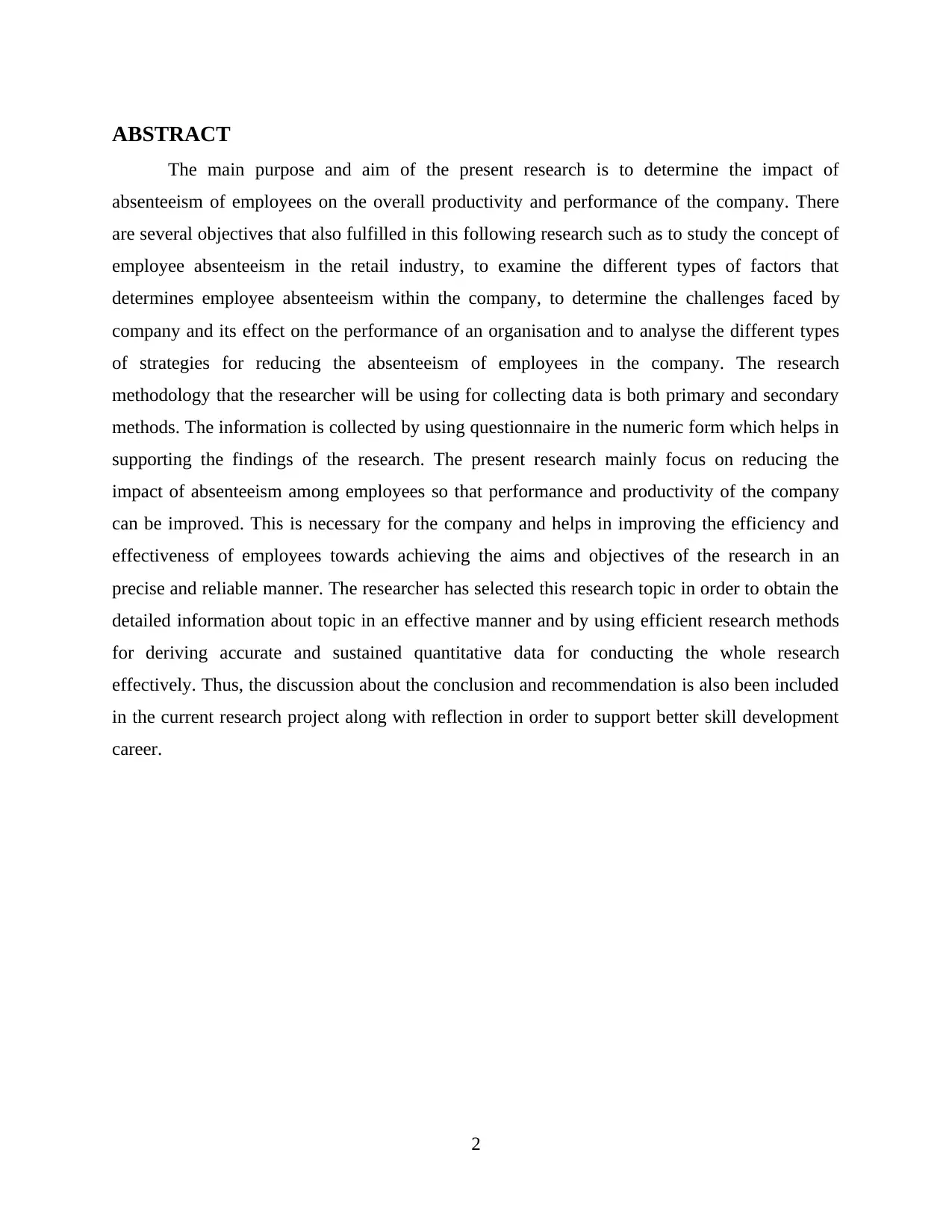
ABSTRACT
The main purpose and aim of the present research is to determine the impact of
absenteeism of employees on the overall productivity and performance of the company. There
are several objectives that also fulfilled in this following research such as to study the concept of
employee absenteeism in the retail industry, to examine the different types of factors that
determines employee absenteeism within the company, to determine the challenges faced by
company and its effect on the performance of an organisation and to analyse the different types
of strategies for reducing the absenteeism of employees in the company. The research
methodology that the researcher will be using for collecting data is both primary and secondary
methods. The information is collected by using questionnaire in the numeric form which helps in
supporting the findings of the research. The present research mainly focus on reducing the
impact of absenteeism among employees so that performance and productivity of the company
can be improved. This is necessary for the company and helps in improving the efficiency and
effectiveness of employees towards achieving the aims and objectives of the research in an
precise and reliable manner. The researcher has selected this research topic in order to obtain the
detailed information about topic in an effective manner and by using efficient research methods
for deriving accurate and sustained quantitative data for conducting the whole research
effectively. Thus, the discussion about the conclusion and recommendation is also been included
in the current research project along with reflection in order to support better skill development
career.
2
The main purpose and aim of the present research is to determine the impact of
absenteeism of employees on the overall productivity and performance of the company. There
are several objectives that also fulfilled in this following research such as to study the concept of
employee absenteeism in the retail industry, to examine the different types of factors that
determines employee absenteeism within the company, to determine the challenges faced by
company and its effect on the performance of an organisation and to analyse the different types
of strategies for reducing the absenteeism of employees in the company. The research
methodology that the researcher will be using for collecting data is both primary and secondary
methods. The information is collected by using questionnaire in the numeric form which helps in
supporting the findings of the research. The present research mainly focus on reducing the
impact of absenteeism among employees so that performance and productivity of the company
can be improved. This is necessary for the company and helps in improving the efficiency and
effectiveness of employees towards achieving the aims and objectives of the research in an
precise and reliable manner. The researcher has selected this research topic in order to obtain the
detailed information about topic in an effective manner and by using efficient research methods
for deriving accurate and sustained quantitative data for conducting the whole research
effectively. Thus, the discussion about the conclusion and recommendation is also been included
in the current research project along with reflection in order to support better skill development
career.
2
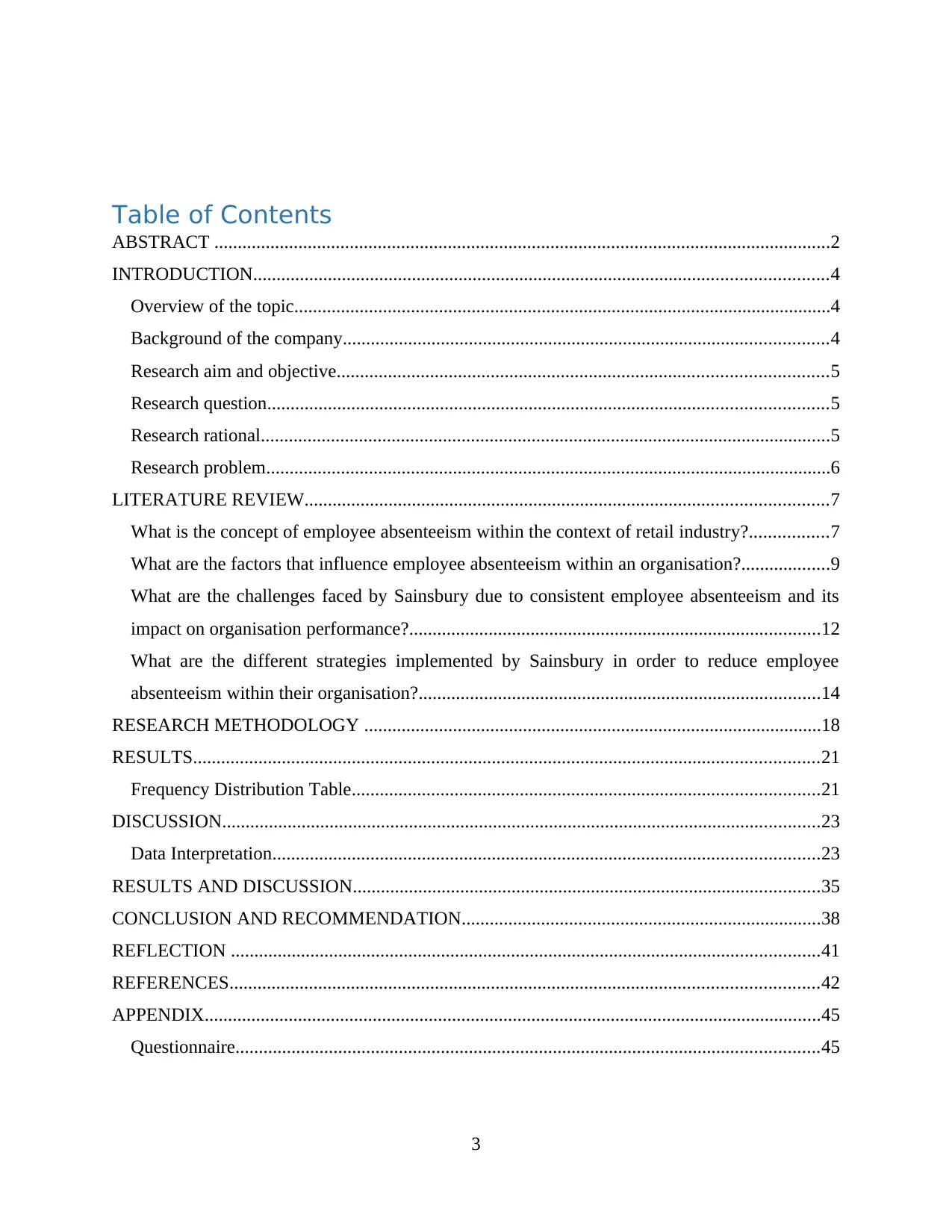
Table of Contents
ABSTRACT ....................................................................................................................................2
INTRODUCTION...........................................................................................................................4
Overview of the topic...................................................................................................................4
Background of the company........................................................................................................4
Research aim and objective.........................................................................................................5
Research question........................................................................................................................5
Research rational..........................................................................................................................5
Research problem.........................................................................................................................6
LITERATURE REVIEW................................................................................................................7
What is the concept of employee absenteeism within the context of retail industry?.................7
What are the factors that influence employee absenteeism within an organisation?...................9
What are the challenges faced by Sainsbury due to consistent employee absenteeism and its
impact on organisation performance?........................................................................................12
What are the different strategies implemented by Sainsbury in order to reduce employee
absenteeism within their organisation?......................................................................................14
RESEARCH METHODOLOGY ..................................................................................................18
RESULTS......................................................................................................................................21
Frequency Distribution Table....................................................................................................21
DISCUSSION................................................................................................................................23
Data Interpretation.....................................................................................................................23
RESULTS AND DISCUSSION....................................................................................................35
CONCLUSION AND RECOMMENDATION.............................................................................38
REFLECTION ..............................................................................................................................41
REFERENCES..............................................................................................................................42
APPENDIX....................................................................................................................................45
Questionnaire.............................................................................................................................45
3
ABSTRACT ....................................................................................................................................2
INTRODUCTION...........................................................................................................................4
Overview of the topic...................................................................................................................4
Background of the company........................................................................................................4
Research aim and objective.........................................................................................................5
Research question........................................................................................................................5
Research rational..........................................................................................................................5
Research problem.........................................................................................................................6
LITERATURE REVIEW................................................................................................................7
What is the concept of employee absenteeism within the context of retail industry?.................7
What are the factors that influence employee absenteeism within an organisation?...................9
What are the challenges faced by Sainsbury due to consistent employee absenteeism and its
impact on organisation performance?........................................................................................12
What are the different strategies implemented by Sainsbury in order to reduce employee
absenteeism within their organisation?......................................................................................14
RESEARCH METHODOLOGY ..................................................................................................18
RESULTS......................................................................................................................................21
Frequency Distribution Table....................................................................................................21
DISCUSSION................................................................................................................................23
Data Interpretation.....................................................................................................................23
RESULTS AND DISCUSSION....................................................................................................35
CONCLUSION AND RECOMMENDATION.............................................................................38
REFLECTION ..............................................................................................................................41
REFERENCES..............................................................................................................................42
APPENDIX....................................................................................................................................45
Questionnaire.............................................................................................................................45
3
⊘ This is a preview!⊘
Do you want full access?
Subscribe today to unlock all pages.

Trusted by 1+ million students worldwide

INTRODUCTION
Overview of the topic
Employee absenteeism can be defined as the absence made by the employee apart from the
accepted time span. The habitual behavior of the employee to take frequent leaves in known as
absenteeism. In this employee does not come to the workplace and perform their duty. It is
being seeing that employee absenteeism impact the organizational performance in negative
manner (Karatepe, Rezapouraghdam and Hassannia, 2020). Absenteeism in the organisation
occur because of many reason. Some of them are low employee engagement, less motivation,
workplace burnout, mental illness, family issue and many more. There are two types of
employee absenteeism that are:
Culpable absenteeism: This is that type of absenteeism where employee does not
provide the legitimate reason for not coming to work.
Non culpable absenteeism: In this staff provide the valid and legitimate reason for
missing the work or not coming to the work.
It is very important for the organisation to look out the factor of employee absenteeism
because it affect their organizational performance in poor manner. Organisational performance
can be defined as the process of measuring the actual result of the company with the standard
result. It is very important for the company to match their actual outcome with stander because it
helps them in attaining aim and objective. There are various types to measure organizational
performance such as human resource outcomes, accounting result, capital market result and
many more (Dyrbye and et. al, 2019).
In recent time employee absenteeism is a very serious concern because human resources are
the biggest assets for the company. Through their efforts and skills, the actual business operation
is being conducted. High absenteeism arte impact the market image of the brand which affect the
recruitment and selection process of the organisation. Loss of productivity is one of the major
concern of employee absenteeism which directly affect the revenue capacity of the firm as well
as increase the cost of capital (Hansen, Løkke and Sørensen, 2019).
Background of the company
The selected organisation for the current investigation is Sainsbury. It is the second largest
supermarket store in United Kingdom. The company hold 16% of the total UK market share. The
4
Overview of the topic
Employee absenteeism can be defined as the absence made by the employee apart from the
accepted time span. The habitual behavior of the employee to take frequent leaves in known as
absenteeism. In this employee does not come to the workplace and perform their duty. It is
being seeing that employee absenteeism impact the organizational performance in negative
manner (Karatepe, Rezapouraghdam and Hassannia, 2020). Absenteeism in the organisation
occur because of many reason. Some of them are low employee engagement, less motivation,
workplace burnout, mental illness, family issue and many more. There are two types of
employee absenteeism that are:
Culpable absenteeism: This is that type of absenteeism where employee does not
provide the legitimate reason for not coming to work.
Non culpable absenteeism: In this staff provide the valid and legitimate reason for
missing the work or not coming to the work.
It is very important for the organisation to look out the factor of employee absenteeism
because it affect their organizational performance in poor manner. Organisational performance
can be defined as the process of measuring the actual result of the company with the standard
result. It is very important for the company to match their actual outcome with stander because it
helps them in attaining aim and objective. There are various types to measure organizational
performance such as human resource outcomes, accounting result, capital market result and
many more (Dyrbye and et. al, 2019).
In recent time employee absenteeism is a very serious concern because human resources are
the biggest assets for the company. Through their efforts and skills, the actual business operation
is being conducted. High absenteeism arte impact the market image of the brand which affect the
recruitment and selection process of the organisation. Loss of productivity is one of the major
concern of employee absenteeism which directly affect the revenue capacity of the firm as well
as increase the cost of capital (Hansen, Løkke and Sørensen, 2019).
Background of the company
The selected organisation for the current investigation is Sainsbury. It is the second largest
supermarket store in United Kingdom. The company hold 16% of the total UK market share. The
4
Paraphrase This Document
Need a fresh take? Get an instant paraphrase of this document with our AI Paraphraser
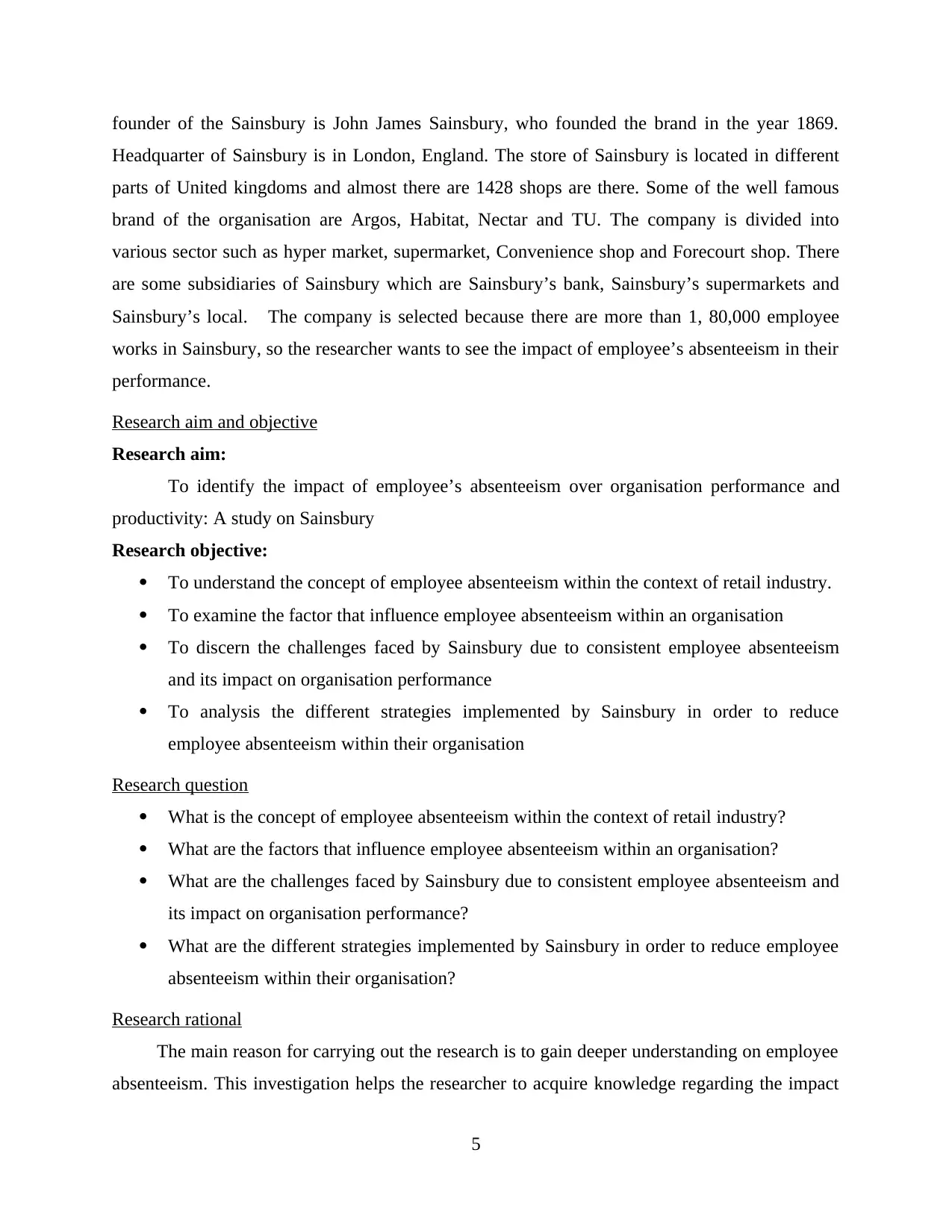
founder of the Sainsbury is John James Sainsbury, who founded the brand in the year 1869.
Headquarter of Sainsbury is in London, England. The store of Sainsbury is located in different
parts of United kingdoms and almost there are 1428 shops are there. Some of the well famous
brand of the organisation are Argos, Habitat, Nectar and TU. The company is divided into
various sector such as hyper market, supermarket, Convenience shop and Forecourt shop. There
are some subsidiaries of Sainsbury which are Sainsbury’s bank, Sainsbury’s supermarkets and
Sainsbury’s local. The company is selected because there are more than 1, 80,000 employee
works in Sainsbury, so the researcher wants to see the impact of employee’s absenteeism in their
performance.
Research aim and objective
Research aim:
To identify the impact of employee’s absenteeism over organisation performance and
productivity: A study on Sainsbury
Research objective:
To understand the concept of employee absenteeism within the context of retail industry.
To examine the factor that influence employee absenteeism within an organisation
To discern the challenges faced by Sainsbury due to consistent employee absenteeism
and its impact on organisation performance
To analysis the different strategies implemented by Sainsbury in order to reduce
employee absenteeism within their organisation
Research question
What is the concept of employee absenteeism within the context of retail industry?
What are the factors that influence employee absenteeism within an organisation?
What are the challenges faced by Sainsbury due to consistent employee absenteeism and
its impact on organisation performance?
What are the different strategies implemented by Sainsbury in order to reduce employee
absenteeism within their organisation?
Research rational
The main reason for carrying out the research is to gain deeper understanding on employee
absenteeism. This investigation helps the researcher to acquire knowledge regarding the impact
5
Headquarter of Sainsbury is in London, England. The store of Sainsbury is located in different
parts of United kingdoms and almost there are 1428 shops are there. Some of the well famous
brand of the organisation are Argos, Habitat, Nectar and TU. The company is divided into
various sector such as hyper market, supermarket, Convenience shop and Forecourt shop. There
are some subsidiaries of Sainsbury which are Sainsbury’s bank, Sainsbury’s supermarkets and
Sainsbury’s local. The company is selected because there are more than 1, 80,000 employee
works in Sainsbury, so the researcher wants to see the impact of employee’s absenteeism in their
performance.
Research aim and objective
Research aim:
To identify the impact of employee’s absenteeism over organisation performance and
productivity: A study on Sainsbury
Research objective:
To understand the concept of employee absenteeism within the context of retail industry.
To examine the factor that influence employee absenteeism within an organisation
To discern the challenges faced by Sainsbury due to consistent employee absenteeism
and its impact on organisation performance
To analysis the different strategies implemented by Sainsbury in order to reduce
employee absenteeism within their organisation
Research question
What is the concept of employee absenteeism within the context of retail industry?
What are the factors that influence employee absenteeism within an organisation?
What are the challenges faced by Sainsbury due to consistent employee absenteeism and
its impact on organisation performance?
What are the different strategies implemented by Sainsbury in order to reduce employee
absenteeism within their organisation?
Research rational
The main reason for carrying out the research is to gain deeper understanding on employee
absenteeism. This investigation helps the researcher to acquire knowledge regarding the impact
5
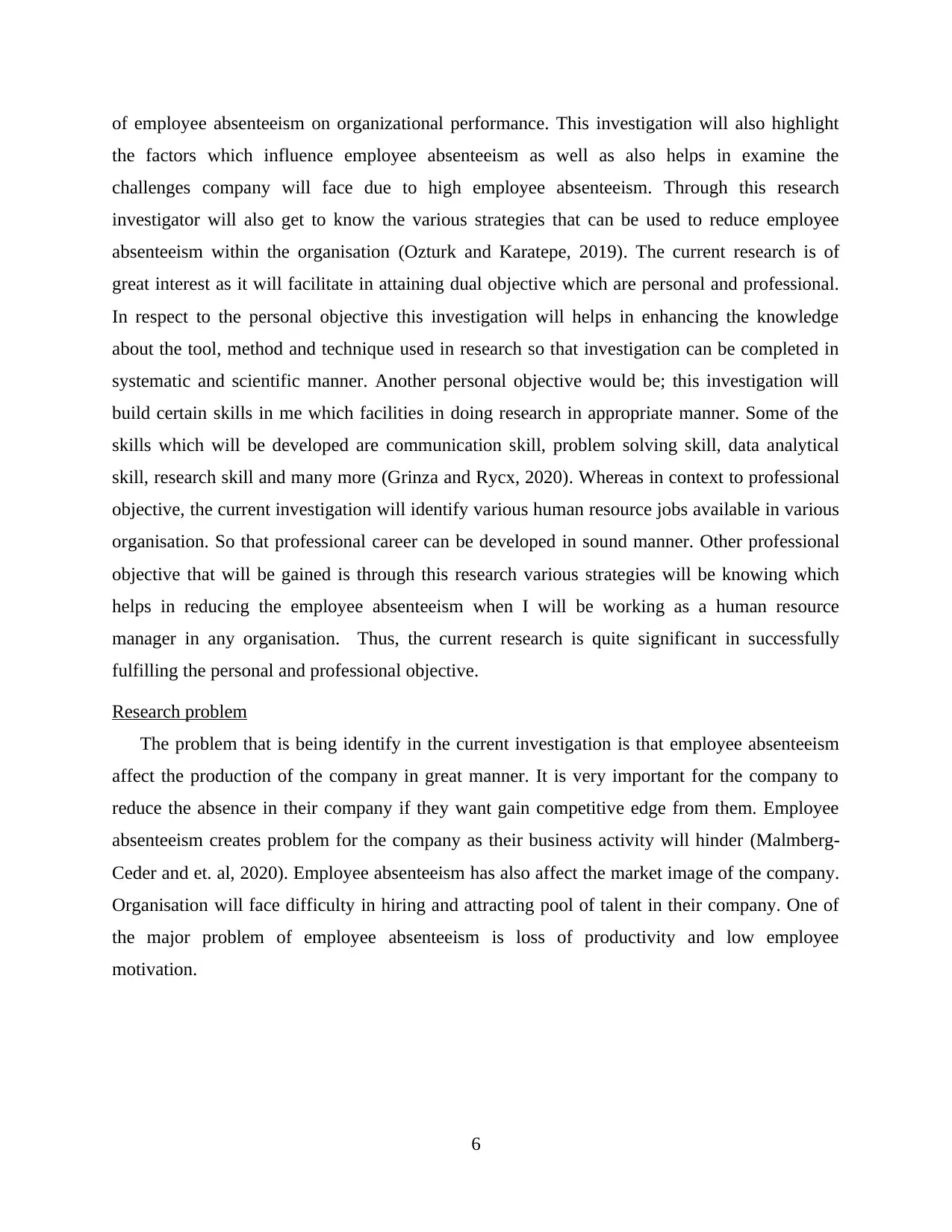
of employee absenteeism on organizational performance. This investigation will also highlight
the factors which influence employee absenteeism as well as also helps in examine the
challenges company will face due to high employee absenteeism. Through this research
investigator will also get to know the various strategies that can be used to reduce employee
absenteeism within the organisation (Ozturk and Karatepe, 2019). The current research is of
great interest as it will facilitate in attaining dual objective which are personal and professional.
In respect to the personal objective this investigation will helps in enhancing the knowledge
about the tool, method and technique used in research so that investigation can be completed in
systematic and scientific manner. Another personal objective would be; this investigation will
build certain skills in me which facilities in doing research in appropriate manner. Some of the
skills which will be developed are communication skill, problem solving skill, data analytical
skill, research skill and many more (Grinza and Rycx, 2020). Whereas in context to professional
objective, the current investigation will identify various human resource jobs available in various
organisation. So that professional career can be developed in sound manner. Other professional
objective that will be gained is through this research various strategies will be knowing which
helps in reducing the employee absenteeism when I will be working as a human resource
manager in any organisation. Thus, the current research is quite significant in successfully
fulfilling the personal and professional objective.
Research problem
The problem that is being identify in the current investigation is that employee absenteeism
affect the production of the company in great manner. It is very important for the company to
reduce the absence in their company if they want gain competitive edge from them. Employee
absenteeism creates problem for the company as their business activity will hinder (Malmberg-
Ceder and et. al, 2020). Employee absenteeism has also affect the market image of the company.
Organisation will face difficulty in hiring and attracting pool of talent in their company. One of
the major problem of employee absenteeism is loss of productivity and low employee
motivation.
6
the factors which influence employee absenteeism as well as also helps in examine the
challenges company will face due to high employee absenteeism. Through this research
investigator will also get to know the various strategies that can be used to reduce employee
absenteeism within the organisation (Ozturk and Karatepe, 2019). The current research is of
great interest as it will facilitate in attaining dual objective which are personal and professional.
In respect to the personal objective this investigation will helps in enhancing the knowledge
about the tool, method and technique used in research so that investigation can be completed in
systematic and scientific manner. Another personal objective would be; this investigation will
build certain skills in me which facilities in doing research in appropriate manner. Some of the
skills which will be developed are communication skill, problem solving skill, data analytical
skill, research skill and many more (Grinza and Rycx, 2020). Whereas in context to professional
objective, the current investigation will identify various human resource jobs available in various
organisation. So that professional career can be developed in sound manner. Other professional
objective that will be gained is through this research various strategies will be knowing which
helps in reducing the employee absenteeism when I will be working as a human resource
manager in any organisation. Thus, the current research is quite significant in successfully
fulfilling the personal and professional objective.
Research problem
The problem that is being identify in the current investigation is that employee absenteeism
affect the production of the company in great manner. It is very important for the company to
reduce the absence in their company if they want gain competitive edge from them. Employee
absenteeism creates problem for the company as their business activity will hinder (Malmberg-
Ceder and et. al, 2020). Employee absenteeism has also affect the market image of the company.
Organisation will face difficulty in hiring and attracting pool of talent in their company. One of
the major problem of employee absenteeism is loss of productivity and low employee
motivation.
6
⊘ This is a preview!⊘
Do you want full access?
Subscribe today to unlock all pages.

Trusted by 1+ million students worldwide

LITERATURE REVIEW
It is the chapter that covers second-hand information about the chosen research topic. This
focuses over addressing each research question in such a way that aim of the study could be
easily attained. The secondary sources used in the present study are: books, magazines,
newspapers, publications, articles, already conducted interviews, questionnaire and so on.
What is the concept of employee absenteeism within the context of retail industry?
According to Zondo (2020), absenteeism is defined as the term which shows the habitual
non-presence of individuals working in the organisation. Habitual non-presence increases
beyond what is deemed to be within an acceptable realm of days away from the organisation for
legitimate reasons such as emergency in family, occasional illness and scheduled leaves and
vacations. Possible reasons of over-absenteeism involve ongoing personal challenges, job
dissatisfaction and chronic medical issues and challenges. Without having any proper reason, an
employee who takes continuous leave may tarnish their own reputation in the workplace and this
directly impacts their long-term employability negatively. But, there are some of the reasons of
absenteeism in the organisation that are acceptable as well as legally protected. Organisations
expect their workforce to miss some operations every year for legitimate reasons. However,
when an employee takes continuous leave or remain absent from their work then it directly
impacts the operations and functions of the organisation. Missing opportunities or work become
one of the challenges for an organisation when an employee is repeatedly or unexpectedly
absent. Companies has to go through many challenges when employees are absent and they get
more worried when they have to pay their employees even though they were absent for their
work. It becomes one of the major problems when an employee is missing from their assigned
roles and responsibilities during deadlines of the projects and busy times of the year.
Therefore, employee absenteeism within retail sector has a negative impact over
organisations, with both operational and financial challenges. It simply creates burden on the
team of HR, who require to find out more alternatives to cover the hours an individual is absent.
Employee absenteeism creates a negative atmosphere within the different teams and departments
of the organisation. When an employee is absent unexpectedly and take continuously leave then
it also lead to poor customer service. This becomes the main reason to adopt different strategies
to control and reduce employee absenteeism in the workplace. This will help retail companies to
7
It is the chapter that covers second-hand information about the chosen research topic. This
focuses over addressing each research question in such a way that aim of the study could be
easily attained. The secondary sources used in the present study are: books, magazines,
newspapers, publications, articles, already conducted interviews, questionnaire and so on.
What is the concept of employee absenteeism within the context of retail industry?
According to Zondo (2020), absenteeism is defined as the term which shows the habitual
non-presence of individuals working in the organisation. Habitual non-presence increases
beyond what is deemed to be within an acceptable realm of days away from the organisation for
legitimate reasons such as emergency in family, occasional illness and scheduled leaves and
vacations. Possible reasons of over-absenteeism involve ongoing personal challenges, job
dissatisfaction and chronic medical issues and challenges. Without having any proper reason, an
employee who takes continuous leave may tarnish their own reputation in the workplace and this
directly impacts their long-term employability negatively. But, there are some of the reasons of
absenteeism in the organisation that are acceptable as well as legally protected. Organisations
expect their workforce to miss some operations every year for legitimate reasons. However,
when an employee takes continuous leave or remain absent from their work then it directly
impacts the operations and functions of the organisation. Missing opportunities or work become
one of the challenges for an organisation when an employee is repeatedly or unexpectedly
absent. Companies has to go through many challenges when employees are absent and they get
more worried when they have to pay their employees even though they were absent for their
work. It becomes one of the major problems when an employee is missing from their assigned
roles and responsibilities during deadlines of the projects and busy times of the year.
Therefore, employee absenteeism within retail sector has a negative impact over
organisations, with both operational and financial challenges. It simply creates burden on the
team of HR, who require to find out more alternatives to cover the hours an individual is absent.
Employee absenteeism creates a negative atmosphere within the different teams and departments
of the organisation. When an employee is absent unexpectedly and take continuously leave then
it also lead to poor customer service. This becomes the main reason to adopt different strategies
to control and reduce employee absenteeism in the workplace. This will help retail companies to
7
Paraphrase This Document
Need a fresh take? Get an instant paraphrase of this document with our AI Paraphraser
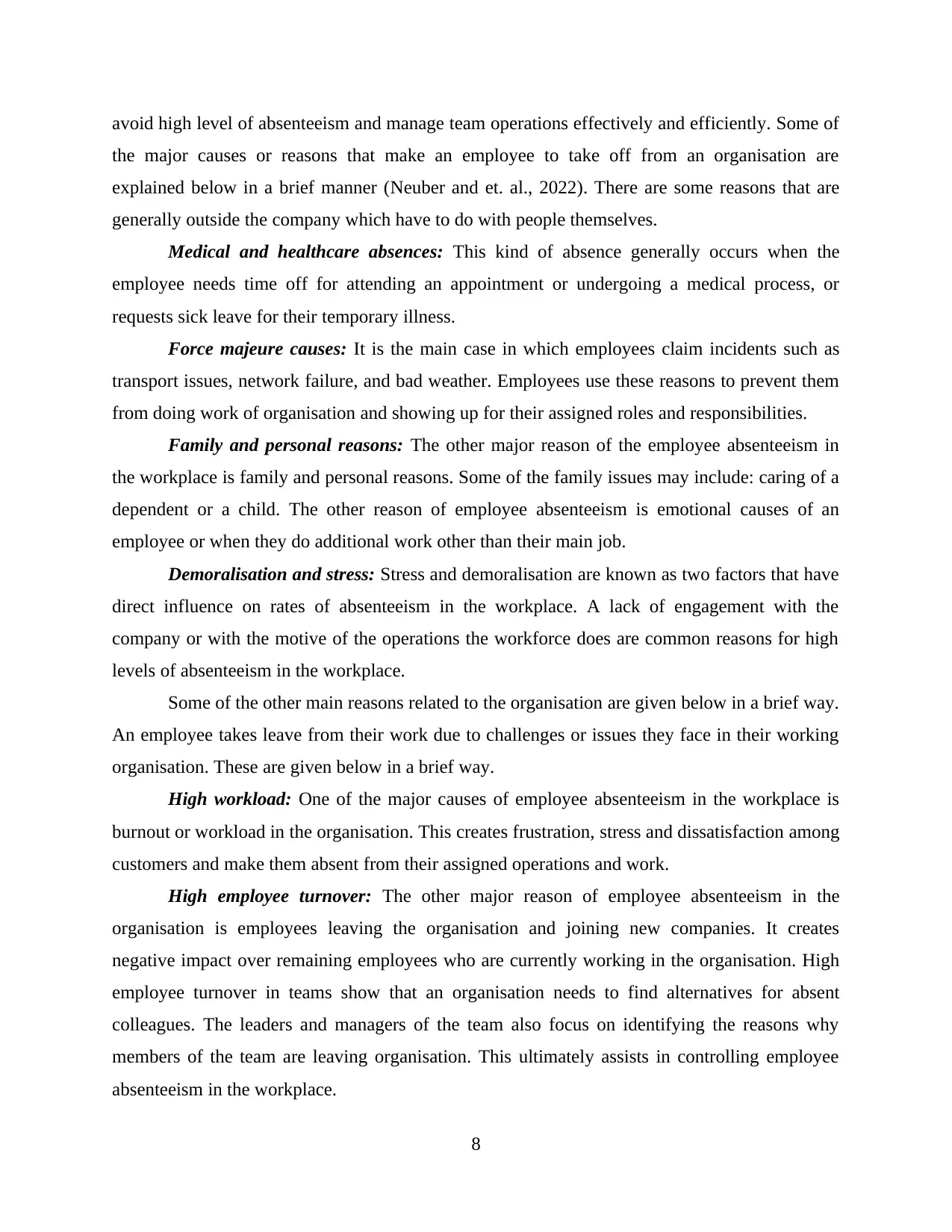
avoid high level of absenteeism and manage team operations effectively and efficiently. Some of
the major causes or reasons that make an employee to take off from an organisation are
explained below in a brief manner (Neuber and et. al., 2022). There are some reasons that are
generally outside the company which have to do with people themselves.
Medical and healthcare absences: This kind of absence generally occurs when the
employee needs time off for attending an appointment or undergoing a medical process, or
requests sick leave for their temporary illness.
Force majeure causes: It is the main case in which employees claim incidents such as
transport issues, network failure, and bad weather. Employees use these reasons to prevent them
from doing work of organisation and showing up for their assigned roles and responsibilities.
Family and personal reasons: The other major reason of the employee absenteeism in
the workplace is family and personal reasons. Some of the family issues may include: caring of a
dependent or a child. The other reason of employee absenteeism is emotional causes of an
employee or when they do additional work other than their main job.
Demoralisation and stress: Stress and demoralisation are known as two factors that have
direct influence on rates of absenteeism in the workplace. A lack of engagement with the
company or with the motive of the operations the workforce does are common reasons for high
levels of absenteeism in the workplace.
Some of the other main reasons related to the organisation are given below in a brief way.
An employee takes leave from their work due to challenges or issues they face in their working
organisation. These are given below in a brief way.
High workload: One of the major causes of employee absenteeism in the workplace is
burnout or workload in the organisation. This creates frustration, stress and dissatisfaction among
customers and make them absent from their assigned operations and work.
High employee turnover: The other major reason of employee absenteeism in the
organisation is employees leaving the organisation and joining new companies. It creates
negative impact over remaining employees who are currently working in the organisation. High
employee turnover in teams show that an organisation needs to find alternatives for absent
colleagues. The leaders and managers of the team also focus on identifying the reasons why
members of the team are leaving organisation. This ultimately assists in controlling employee
absenteeism in the workplace.
8
the major causes or reasons that make an employee to take off from an organisation are
explained below in a brief manner (Neuber and et. al., 2022). There are some reasons that are
generally outside the company which have to do with people themselves.
Medical and healthcare absences: This kind of absence generally occurs when the
employee needs time off for attending an appointment or undergoing a medical process, or
requests sick leave for their temporary illness.
Force majeure causes: It is the main case in which employees claim incidents such as
transport issues, network failure, and bad weather. Employees use these reasons to prevent them
from doing work of organisation and showing up for their assigned roles and responsibilities.
Family and personal reasons: The other major reason of the employee absenteeism in
the workplace is family and personal reasons. Some of the family issues may include: caring of a
dependent or a child. The other reason of employee absenteeism is emotional causes of an
employee or when they do additional work other than their main job.
Demoralisation and stress: Stress and demoralisation are known as two factors that have
direct influence on rates of absenteeism in the workplace. A lack of engagement with the
company or with the motive of the operations the workforce does are common reasons for high
levels of absenteeism in the workplace.
Some of the other main reasons related to the organisation are given below in a brief way.
An employee takes leave from their work due to challenges or issues they face in their working
organisation. These are given below in a brief way.
High workload: One of the major causes of employee absenteeism in the workplace is
burnout or workload in the organisation. This creates frustration, stress and dissatisfaction among
customers and make them absent from their assigned operations and work.
High employee turnover: The other major reason of employee absenteeism in the
organisation is employees leaving the organisation and joining new companies. It creates
negative impact over remaining employees who are currently working in the organisation. High
employee turnover in teams show that an organisation needs to find alternatives for absent
colleagues. The leaders and managers of the team also focus on identifying the reasons why
members of the team are leaving organisation. This ultimately assists in controlling employee
absenteeism in the workplace.
8
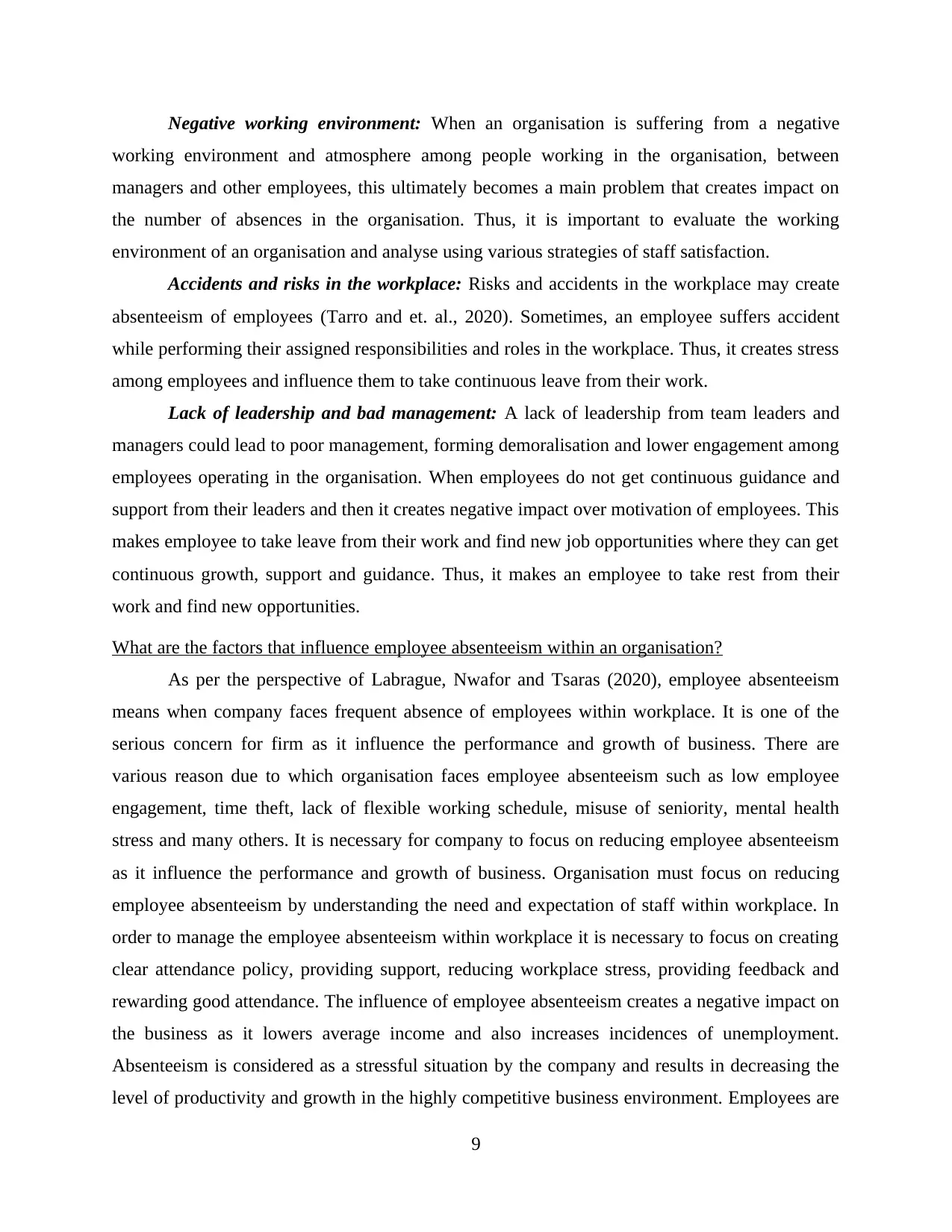
Negative working environment: When an organisation is suffering from a negative
working environment and atmosphere among people working in the organisation, between
managers and other employees, this ultimately becomes a main problem that creates impact on
the number of absences in the organisation. Thus, it is important to evaluate the working
environment of an organisation and analyse using various strategies of staff satisfaction.
Accidents and risks in the workplace: Risks and accidents in the workplace may create
absenteeism of employees (Tarro and et. al., 2020). Sometimes, an employee suffers accident
while performing their assigned responsibilities and roles in the workplace. Thus, it creates stress
among employees and influence them to take continuous leave from their work.
Lack of leadership and bad management: A lack of leadership from team leaders and
managers could lead to poor management, forming demoralisation and lower engagement among
employees operating in the organisation. When employees do not get continuous guidance and
support from their leaders and then it creates negative impact over motivation of employees. This
makes employee to take leave from their work and find new job opportunities where they can get
continuous growth, support and guidance. Thus, it makes an employee to take rest from their
work and find new opportunities.
What are the factors that influence employee absenteeism within an organisation?
As per the perspective of Labrague, Nwafor and Tsaras (2020), employee absenteeism
means when company faces frequent absence of employees within workplace. It is one of the
serious concern for firm as it influence the performance and growth of business. There are
various reason due to which organisation faces employee absenteeism such as low employee
engagement, time theft, lack of flexible working schedule, misuse of seniority, mental health
stress and many others. It is necessary for company to focus on reducing employee absenteeism
as it influence the performance and growth of business. Organisation must focus on reducing
employee absenteeism by understanding the need and expectation of staff within workplace. In
order to manage the employee absenteeism within workplace it is necessary to focus on creating
clear attendance policy, providing support, reducing workplace stress, providing feedback and
rewarding good attendance. The influence of employee absenteeism creates a negative impact on
the business as it lowers average income and also increases incidences of unemployment.
Absenteeism is considered as a stressful situation by the company and results in decreasing the
level of productivity and growth in the highly competitive business environment. Employees are
9
working environment and atmosphere among people working in the organisation, between
managers and other employees, this ultimately becomes a main problem that creates impact on
the number of absences in the organisation. Thus, it is important to evaluate the working
environment of an organisation and analyse using various strategies of staff satisfaction.
Accidents and risks in the workplace: Risks and accidents in the workplace may create
absenteeism of employees (Tarro and et. al., 2020). Sometimes, an employee suffers accident
while performing their assigned responsibilities and roles in the workplace. Thus, it creates stress
among employees and influence them to take continuous leave from their work.
Lack of leadership and bad management: A lack of leadership from team leaders and
managers could lead to poor management, forming demoralisation and lower engagement among
employees operating in the organisation. When employees do not get continuous guidance and
support from their leaders and then it creates negative impact over motivation of employees. This
makes employee to take leave from their work and find new job opportunities where they can get
continuous growth, support and guidance. Thus, it makes an employee to take rest from their
work and find new opportunities.
What are the factors that influence employee absenteeism within an organisation?
As per the perspective of Labrague, Nwafor and Tsaras (2020), employee absenteeism
means when company faces frequent absence of employees within workplace. It is one of the
serious concern for firm as it influence the performance and growth of business. There are
various reason due to which organisation faces employee absenteeism such as low employee
engagement, time theft, lack of flexible working schedule, misuse of seniority, mental health
stress and many others. It is necessary for company to focus on reducing employee absenteeism
as it influence the performance and growth of business. Organisation must focus on reducing
employee absenteeism by understanding the need and expectation of staff within workplace. In
order to manage the employee absenteeism within workplace it is necessary to focus on creating
clear attendance policy, providing support, reducing workplace stress, providing feedback and
rewarding good attendance. The influence of employee absenteeism creates a negative impact on
the business as it lowers average income and also increases incidences of unemployment.
Absenteeism is considered as a stressful situation by the company and results in decreasing the
level of productivity and growth in the highly competitive business environment. Employees are
9
⊘ This is a preview!⊘
Do you want full access?
Subscribe today to unlock all pages.

Trusted by 1+ million students worldwide

considered as the most important asset of the company that helps in achieving the predetermined
goals and objectives of the business. Absenteeism means when an employee working in the
company do not appear at the workplace for some days or on the particular scheduled time for
conducting the working activities of the business. The reason behind leaving the workplace more
often can be because of illness or an emergency which impacts the performance and productivity
of the business operations of the company. Absenteeism at the company can occur because of
several avoidable and unavoidable reasons and these reasons affects their working efficiency and
effectiveness. There are various factors that influence employee absenteeism within business
they are as follows:
Negative working environment:
Negative working environment is one of the factor which increases employee
absenteeism within workplace. If organisation has negative working environment that reduces
the motivation and morale level of staff it becomes challenging to achieve the business goals and
objective in effective and efficient manner. The negative working environment can influence the
profitability and growth of business. It is necessary for an organisation to develop positive
working environment for their employees so that they can work productively and also contribute
their best performance in accomplishing business target (Grinza and Rycx, 2020). Negative
working environment leads to lack of recognition, high turnover, unhealthy communication and
gossiping.
Mental health issues:
Mental health issue is another factor that influence employee absenteeism within
workplace. While working in company, employee faces work load and stress which creates an
impact on the health issues of employees. For staff it is important to have sound mental health so
that they can give their better performance in accomplishing the work and target. The mental
health issue of staff also reduces their performance due to which they give poor results which
affects the growth and productivity of business. Employees face the problem related to mental
issues and this reduce their working capability and efficiency in attaining high growth and
profitability of the company in the competitive environment. Mental issues can be due to high
stress, depression, anxiety, or illness which leads to reduction in the performance and
productivity of employees to work effectively and efficiently.
No appreciation and reward:
10
goals and objectives of the business. Absenteeism means when an employee working in the
company do not appear at the workplace for some days or on the particular scheduled time for
conducting the working activities of the business. The reason behind leaving the workplace more
often can be because of illness or an emergency which impacts the performance and productivity
of the business operations of the company. Absenteeism at the company can occur because of
several avoidable and unavoidable reasons and these reasons affects their working efficiency and
effectiveness. There are various factors that influence employee absenteeism within business
they are as follows:
Negative working environment:
Negative working environment is one of the factor which increases employee
absenteeism within workplace. If organisation has negative working environment that reduces
the motivation and morale level of staff it becomes challenging to achieve the business goals and
objective in effective and efficient manner. The negative working environment can influence the
profitability and growth of business. It is necessary for an organisation to develop positive
working environment for their employees so that they can work productively and also contribute
their best performance in accomplishing business target (Grinza and Rycx, 2020). Negative
working environment leads to lack of recognition, high turnover, unhealthy communication and
gossiping.
Mental health issues:
Mental health issue is another factor that influence employee absenteeism within
workplace. While working in company, employee faces work load and stress which creates an
impact on the health issues of employees. For staff it is important to have sound mental health so
that they can give their better performance in accomplishing the work and target. The mental
health issue of staff also reduces their performance due to which they give poor results which
affects the growth and productivity of business. Employees face the problem related to mental
issues and this reduce their working capability and efficiency in attaining high growth and
profitability of the company in the competitive environment. Mental issues can be due to high
stress, depression, anxiety, or illness which leads to reduction in the performance and
productivity of employees to work effectively and efficiently.
No appreciation and reward:
10
Paraphrase This Document
Need a fresh take? Get an instant paraphrase of this document with our AI Paraphraser
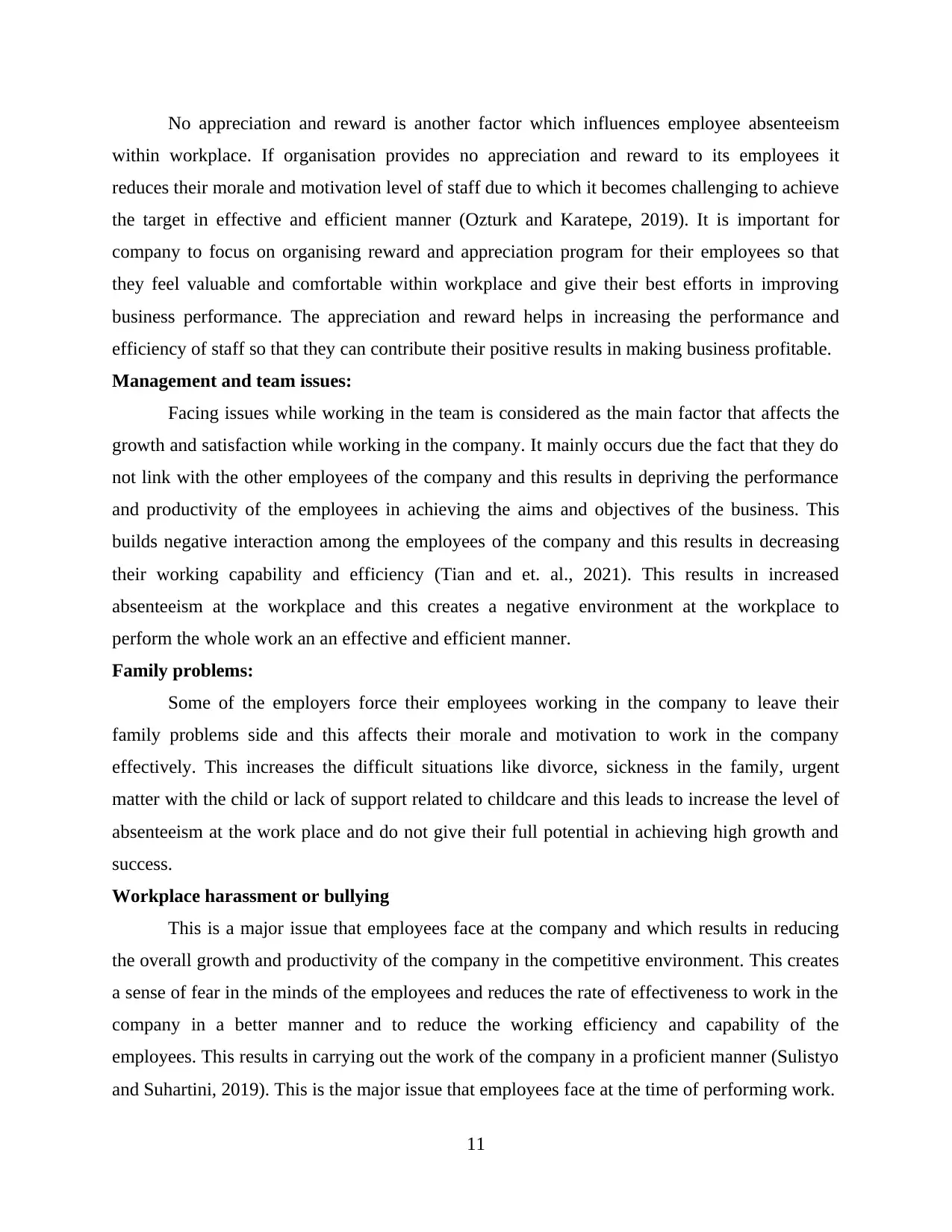
No appreciation and reward is another factor which influences employee absenteeism
within workplace. If organisation provides no appreciation and reward to its employees it
reduces their morale and motivation level of staff due to which it becomes challenging to achieve
the target in effective and efficient manner (Ozturk and Karatepe, 2019). It is important for
company to focus on organising reward and appreciation program for their employees so that
they feel valuable and comfortable within workplace and give their best efforts in improving
business performance. The appreciation and reward helps in increasing the performance and
efficiency of staff so that they can contribute their positive results in making business profitable.
Management and team issues:
Facing issues while working in the team is considered as the main factor that affects the
growth and satisfaction while working in the company. It mainly occurs due the fact that they do
not link with the other employees of the company and this results in depriving the performance
and productivity of the employees in achieving the aims and objectives of the business. This
builds negative interaction among the employees of the company and this results in decreasing
their working capability and efficiency (Tian and et. al., 2021). This results in increased
absenteeism at the workplace and this creates a negative environment at the workplace to
perform the whole work an an effective and efficient manner.
Family problems:
Some of the employers force their employees working in the company to leave their
family problems side and this affects their morale and motivation to work in the company
effectively. This increases the difficult situations like divorce, sickness in the family, urgent
matter with the child or lack of support related to childcare and this leads to increase the level of
absenteeism at the work place and do not give their full potential in achieving high growth and
success.
Workplace harassment or bullying
This is a major issue that employees face at the company and which results in reducing
the overall growth and productivity of the company in the competitive environment. This creates
a sense of fear in the minds of the employees and reduces the rate of effectiveness to work in the
company in a better manner and to reduce the working efficiency and capability of the
employees. This results in carrying out the work of the company in a proficient manner (Sulistyo
and Suhartini, 2019). This is the major issue that employees face at the time of performing work.
11
within workplace. If organisation provides no appreciation and reward to its employees it
reduces their morale and motivation level of staff due to which it becomes challenging to achieve
the target in effective and efficient manner (Ozturk and Karatepe, 2019). It is important for
company to focus on organising reward and appreciation program for their employees so that
they feel valuable and comfortable within workplace and give their best efforts in improving
business performance. The appreciation and reward helps in increasing the performance and
efficiency of staff so that they can contribute their positive results in making business profitable.
Management and team issues:
Facing issues while working in the team is considered as the main factor that affects the
growth and satisfaction while working in the company. It mainly occurs due the fact that they do
not link with the other employees of the company and this results in depriving the performance
and productivity of the employees in achieving the aims and objectives of the business. This
builds negative interaction among the employees of the company and this results in decreasing
their working capability and efficiency (Tian and et. al., 2021). This results in increased
absenteeism at the workplace and this creates a negative environment at the workplace to
perform the whole work an an effective and efficient manner.
Family problems:
Some of the employers force their employees working in the company to leave their
family problems side and this affects their morale and motivation to work in the company
effectively. This increases the difficult situations like divorce, sickness in the family, urgent
matter with the child or lack of support related to childcare and this leads to increase the level of
absenteeism at the work place and do not give their full potential in achieving high growth and
success.
Workplace harassment or bullying
This is a major issue that employees face at the company and which results in reducing
the overall growth and productivity of the company in the competitive environment. This creates
a sense of fear in the minds of the employees and reduces the rate of effectiveness to work in the
company in a better manner and to reduce the working efficiency and capability of the
employees. This results in carrying out the work of the company in a proficient manner (Sulistyo
and Suhartini, 2019). This is the major issue that employees face at the time of performing work.
11
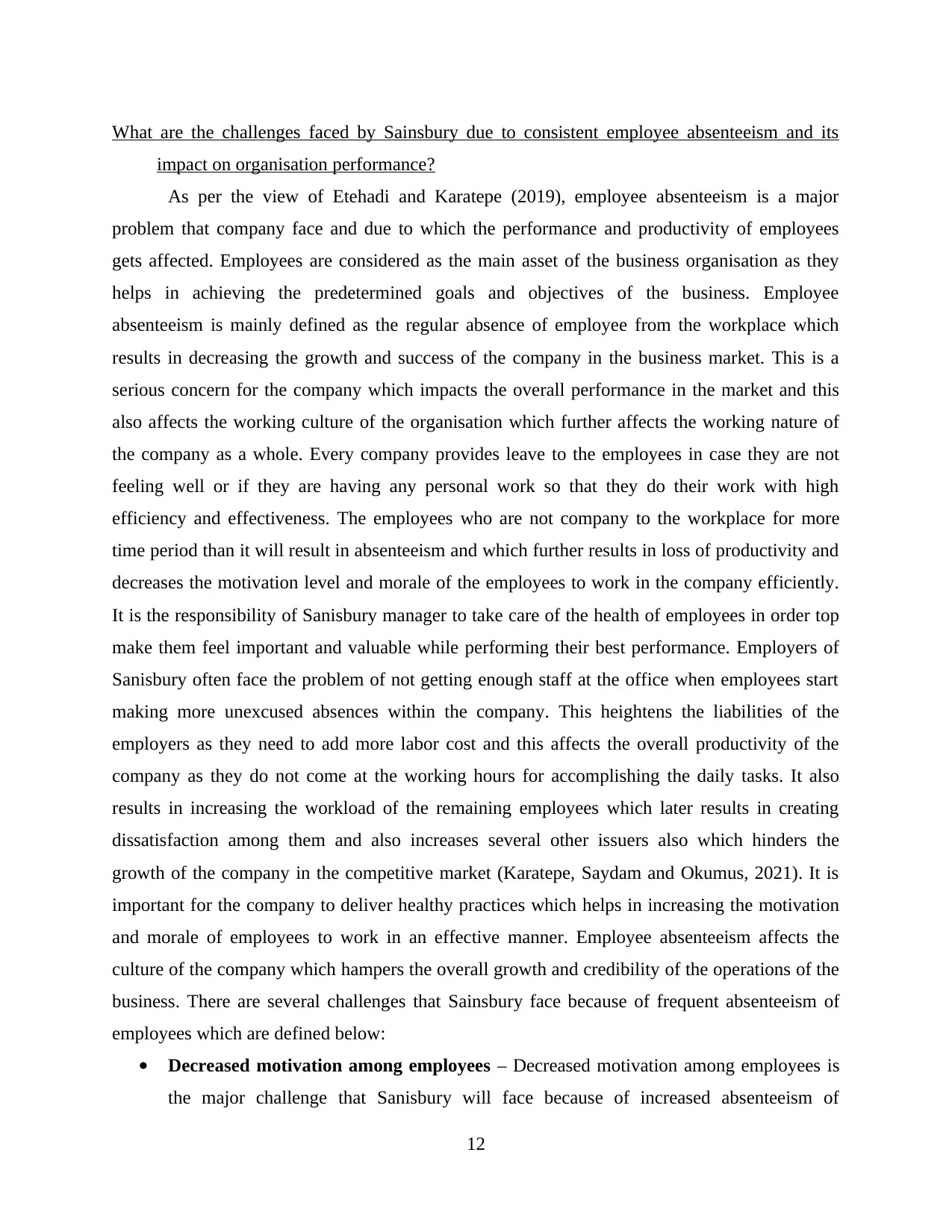
What are the challenges faced by Sainsbury due to consistent employee absenteeism and its
impact on organisation performance?
As per the view of Etehadi and Karatepe (2019), employee absenteeism is a major
problem that company face and due to which the performance and productivity of employees
gets affected. Employees are considered as the main asset of the business organisation as they
helps in achieving the predetermined goals and objectives of the business. Employee
absenteeism is mainly defined as the regular absence of employee from the workplace which
results in decreasing the growth and success of the company in the business market. This is a
serious concern for the company which impacts the overall performance in the market and this
also affects the working culture of the organisation which further affects the working nature of
the company as a whole. Every company provides leave to the employees in case they are not
feeling well or if they are having any personal work so that they do their work with high
efficiency and effectiveness. The employees who are not company to the workplace for more
time period than it will result in absenteeism and which further results in loss of productivity and
decreases the motivation level and morale of the employees to work in the company efficiently.
It is the responsibility of Sanisbury manager to take care of the health of employees in order top
make them feel important and valuable while performing their best performance. Employers of
Sanisbury often face the problem of not getting enough staff at the office when employees start
making more unexcused absences within the company. This heightens the liabilities of the
employers as they need to add more labor cost and this affects the overall productivity of the
company as they do not come at the working hours for accomplishing the daily tasks. It also
results in increasing the workload of the remaining employees which later results in creating
dissatisfaction among them and also increases several other issuers also which hinders the
growth of the company in the competitive market (Karatepe, Saydam and Okumus, 2021). It is
important for the company to deliver healthy practices which helps in increasing the motivation
and morale of employees to work in an effective manner. Employee absenteeism affects the
culture of the company which hampers the overall growth and credibility of the operations of the
business. There are several challenges that Sainsbury face because of frequent absenteeism of
employees which are defined below:
Decreased motivation among employees – Decreased motivation among employees is
the major challenge that Sanisbury will face because of increased absenteeism of
12
impact on organisation performance?
As per the view of Etehadi and Karatepe (2019), employee absenteeism is a major
problem that company face and due to which the performance and productivity of employees
gets affected. Employees are considered as the main asset of the business organisation as they
helps in achieving the predetermined goals and objectives of the business. Employee
absenteeism is mainly defined as the regular absence of employee from the workplace which
results in decreasing the growth and success of the company in the business market. This is a
serious concern for the company which impacts the overall performance in the market and this
also affects the working culture of the organisation which further affects the working nature of
the company as a whole. Every company provides leave to the employees in case they are not
feeling well or if they are having any personal work so that they do their work with high
efficiency and effectiveness. The employees who are not company to the workplace for more
time period than it will result in absenteeism and which further results in loss of productivity and
decreases the motivation level and morale of the employees to work in the company efficiently.
It is the responsibility of Sanisbury manager to take care of the health of employees in order top
make them feel important and valuable while performing their best performance. Employers of
Sanisbury often face the problem of not getting enough staff at the office when employees start
making more unexcused absences within the company. This heightens the liabilities of the
employers as they need to add more labor cost and this affects the overall productivity of the
company as they do not come at the working hours for accomplishing the daily tasks. It also
results in increasing the workload of the remaining employees which later results in creating
dissatisfaction among them and also increases several other issuers also which hinders the
growth of the company in the competitive market (Karatepe, Saydam and Okumus, 2021). It is
important for the company to deliver healthy practices which helps in increasing the motivation
and morale of employees to work in an effective manner. Employee absenteeism affects the
culture of the company which hampers the overall growth and credibility of the operations of the
business. There are several challenges that Sainsbury face because of frequent absenteeism of
employees which are defined below:
Decreased motivation among employees – Decreased motivation among employees is
the major challenge that Sanisbury will face because of increased absenteeism of
12
⊘ This is a preview!⊘
Do you want full access?
Subscribe today to unlock all pages.

Trusted by 1+ million students worldwide
1 out of 47
Related Documents
Your All-in-One AI-Powered Toolkit for Academic Success.
+13062052269
info@desklib.com
Available 24*7 on WhatsApp / Email
![[object Object]](/_next/static/media/star-bottom.7253800d.svg)
Unlock your academic potential
Copyright © 2020–2025 A2Z Services. All Rights Reserved. Developed and managed by ZUCOL.




